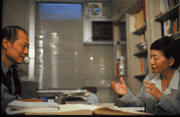| Biohistory journal,Spring, 2005: Index >The difficulty of both the human body and genome to narrate |
| Dialogue/Narration The history of anatomy The difficulty of both the human body and genome to narrate Tatsuo Sakai and Keiko Nakamura | |
| |
| While we want the genome to narrate life for us, we are swamped in the mountain of data. I visited Dr. Sakai, and learned a lot from the process of having deciphered the human body in the several thousand years of history of anatomy. The best of these, however, is the experience in the laboratory. The sensation of alternating between apprehending the body as a substance and being aware of the human being is difficult to obtain through DNA research. It is likely the basis of biological research. (Keiko Nakamura) |
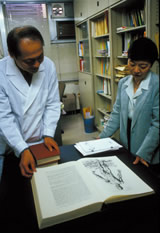 |
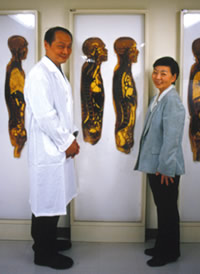 |
After the dialogue / Tatsuo Sakai |
| What is knowing? What is narrating? What is life? Two hours passed by in a flash while participating in this inexhaustible discussion. Even if the objects dealt with, including the genome and the human body, were different, I was surprised at many things with a common resonance when discussing the questions, What is life, and how will human beings explore it. After a while, however, I began to notice there was something different. Just because they are different does not mean that they have to be corrected. Rather, I want to know how they are different. It is probably my proclivity to be dissatisfied until I dissect everything. Dissecting a human being reveals all too many circumstances. There are very few things I can say when the process is finished. Most of them have fallen apart and disappeared during the dissection process. Though there is an indispensable human body that supports the personality and lives of each human being, I suddenly accept the real sensation that it is quite impossible to elucidate it all, and that it is not possible to convey in words alone without the experience of dissecting a human being. |
| A lot of things to be cut out are sure to remain if we go back to the original experience before it is cut out in the world. | 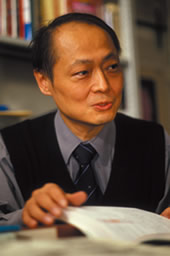 |
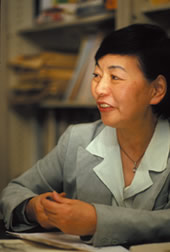 |
Living creatures are essentially different from machines. We can grasp the real image of living creatures by searching for their context not by understanding them as machines. I found that anatomy did the same thing for a long time. |
| From the editors |
| Looking back on his experiences, Dr. Tatsuo Sakai describes the course of development of anatomy, a subject that has been studied since the days of ancient Greece and for which there is a body of information that cannot be expressed by the word “history”. He tells us that the many things can be deciphered from the common experience of dissection using data from times when language was merely for recording and nothing was communicated, and times when there were no illustrations. That’s because the human body doesn’t change. One opens the body and apprehends it in layersÅ\organs, tissue, and cells. That which is capable of reproducing itself are cells, bodies, and seeds. Dr. Nakamura remarked, “Those three layers are important in modern biology, which observes using the genome”. For molecular biology, which deals with the genome, anatomy that deals with the human body is the oldest ancestor that has continued to struggle to make sense of limited subjects that contain much we don’t understand. Anatomy today is described as having a problem with a gap between education and research. If education in anatomy was a question of knowledge alone, computers and books would suffice, but there is much that can be gained only by examining the human body itself. One of the things to be gained is the experience of seriously working with the human body, of which there is only one. Dr. Sakai says it is important to connect this to the approach of research. All that can likely be done to obtain knowledge of the entire organism and not just its constituent elements is to search for the context from one’s experience of the object and narrate that. An awareness of problems and sense are important for research. These cannot be taught—they must be obtained by the individual. Dr. Sakai says one’s ideas are to be sought from among one’s research results, and then created and described. The Biohistory Journal shares this opinion. Dr. Sakai stressed the distinctive characteristics of anatomy, and we agreed. The basic approach toward life is the same. |
Born in Osaka in 1953. After graduating from the School of Medicine at the University of Tokyo, he served as an assistant at the same school, and a researcher at the University of Heidelberg before returning to the University of Tokyo as an associate professor. He is now an anatomy professor at the Juntendo University School of Medicine. In 1995, he served as the head of the executive committee for the special exhibit, “The World of the Human Body”, representing the Japanese Association of Anatomists. He has written many books, the foremost among them being A Natural History of the Body (University of Tokyo Press) and The Mechanism of the Human Body (Nippon Jitsugyo Publishing Co.) |
| Dialogue |
|
Please close a window with the button of a browser who are turning off Javascript. |
